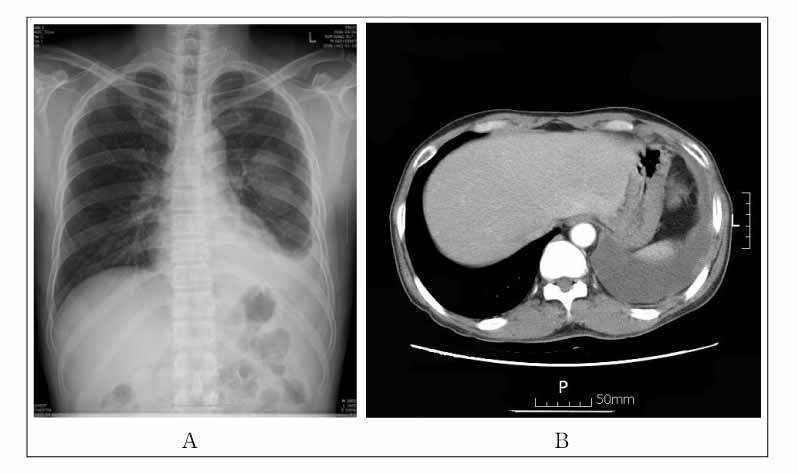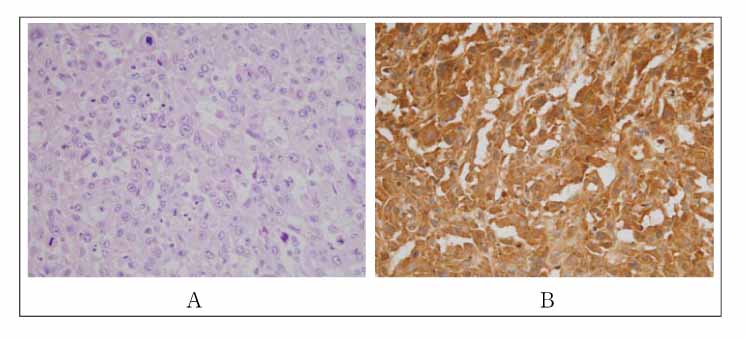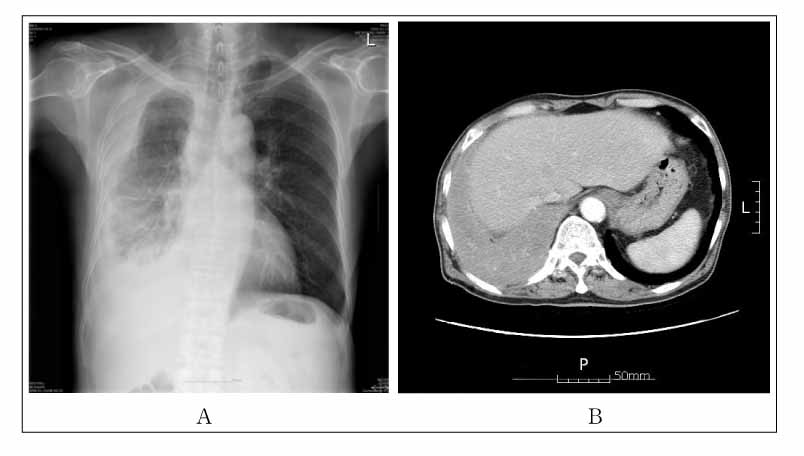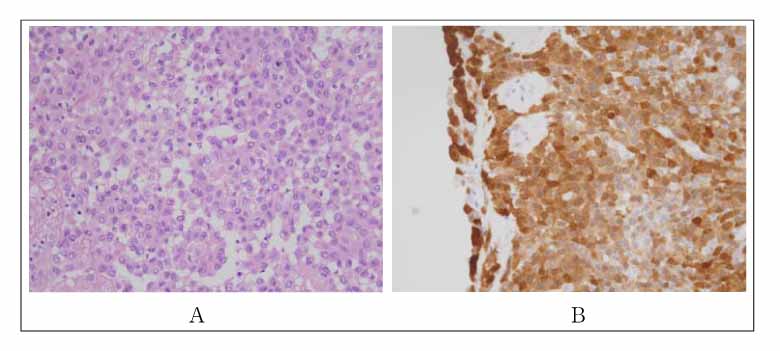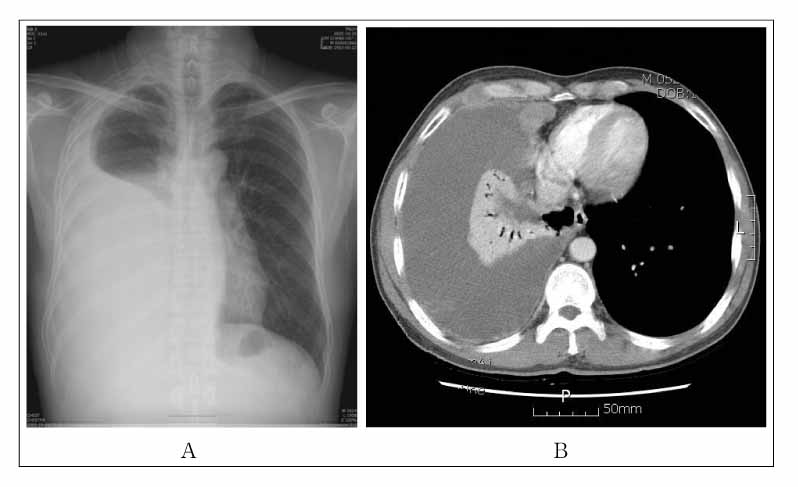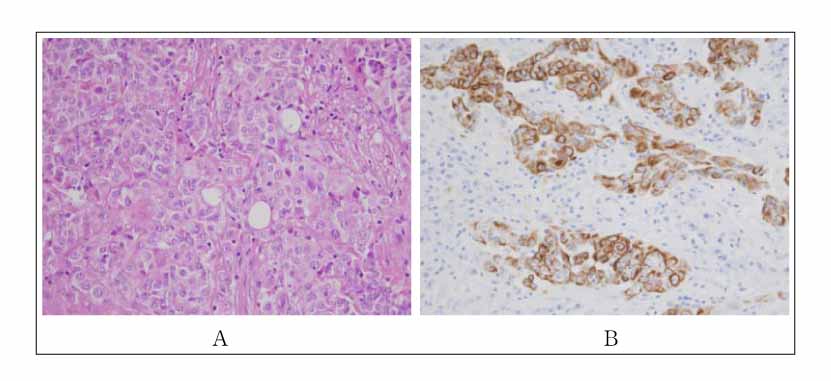Tuberc Respir Dis.
2007 Apr;62(4):323-330. 10.4046/trd.2007.62.4.323.
Three Cases of Malignant Pleural Mesothelioma Misdiagnosed as Tuberculous Pleurisy
- Affiliations
-
- 1Department of Internal Medicine, College of Medicine, Pusan National University, Pusan, Korea.
- 2Department of Thoracic Surgery, College of Medicine, Pusan National University, Pusan, Korea. domini@pnu.edu
- 3Department of Pathology, College of Medicine, Pusan National University, Pusan, Korea.
- KMID: 1970234
- DOI: http://doi.org/10.4046/trd.2007.62.4.323
Abstract
- Malignant pleural mesothelioma(MPM) is an uncommon neoplasm which is originated from pleural mesothelial cells. The majority of MPM is associated with prior asbestos exposure. Patients often present with chest pain and dyspnea due to pleural effusion, which might be diagnosed with tuberculous pleurisy especially in Korea. MPM is well known for its poor prognosis with a median survival time of less than 12 months after diagnosis and no established standard treatment modality. We report 3 cases of MPM confirmed by video-assisted thoracoscopic biopsy first misdiagnosed as tuberculous pleurisy.
MeSH Terms
Figure
Reference
-
1. Ordonez NG. The immunohistochemical diagnosis of mesothelioma. Differentiation of mesothelioma and lung adenocarcinoma. Am J Surg Pathol. 1989. 13:276–291.2. Song HK, Park SI, Cho KH, Kim WY, Chung CK, Oh HK, et al. Clinical review on two cases of pleural mesothelioma. Tuberc Respir Dis. 1977. 24:158–163.3. Kwon C, Kim HG, Rhee YK. A case of malignant mesothelioma with pleural effusion. Tuberc Respir Dis. 1983. 30:219–226.4. Lee MC, Cho CH, Kim SK, Chang J, Kim SK, Lee WY, et al. A case of malignant mesothelioma of pleura associated with hypoglycemia. Tuberc Respir Dis. 1990. 37:428–433.5. Shim TS, Kim HJ, Choe HS, Lee HP, Seo JY, Kim YW, et al. Clinical study on mesothelioma of the pleura. Tuberc Respir Dis. 1991. 38:135–142.6. Park MI, Choi JS, Choi HM, Jang TI, Moon IH, Kim JH, et al. A case of diffuse malignant pleural mesothelioma with occupational asbestos exposure. Korean J Intern Med. 1995. 48:526–530.7. Oh YW, Kim HS, Kim JH, Chung KB, Suh WH. Differentiation between malignant pleural mesothelioma and metastasis of the pleura: CT evaluation. Korea Univ Med J. 1997. 34:25–29.8. Kang DM, Kim JW, Son BC, Kim JI, Woo JC, Lee JT. A case of malignant pleural mesothelioma combined with asbestosis in a boilermaker and plumber. Korean J Occup Environ Med. 1998. 10:610–617.9. Oh HK, Ro JY, Yoon CJ, Chi JG. Analysis of pulmonary asbestos body in malignant mesothelioma. Korean J Pathol. 1999. 33:361–366.10. Kwon JB, Park CB, Kim JH, Kim KH, Park GH, Won YS, et al. Malignant mesothelioma with hypoglycemia. Korean Thorac Cardiovasc Surg. 2000. 33:978–981.11. Wagner JC, Sleggs CA, Marchand P. Diffuse pleural mesothelioma and asbestos exposure in the North Western Cape Province. Br J Ind Med. 1960. 17:260–271.12. Sebastien P, Janson X, Gaudichet A, Hirsch A, Bignon J. Asbestos retention in human respiratory tissues: comparative measurements in lung parenchyma and in parietal pleura. IARC Sci Publ. 1980. 30:237–246.13. Zanella CL, Posada J, Tritton TR, Mossman BT. Asbestos causes stimulation of the extracellular signal-regulated kinase 1 mitogen-activated protein kinase cascade after phosphorylation of the epidermal growth factor receptor. Cancer Res. 1996. 56:5334–5338.14. Vogelzang NJ, Rusthoven JJ, Symanowski J, Denham C, Kaukel E, Ruffie P, et al. Phase III study of pemetrexed in combination with cisplatin versus cisplatin alone in patients with malignant pleural mesothelioma. J Clin Oncol. 2003. 21:2636–2644.15. Nowak AK, Byrne MJ, Williamson R, Ryan G, Segal A, Fielding D, et al. A multicentre phase II study of cisplatin and gemcitabine for malignant mesothelioma. Br J Cancer. 2002. 87:491–496.
- Full Text Links
- Actions
-
Cited
- CITED
-
- Close
- Share
- Similar articles
-
- Malignant mesothelioma mistaken for tuberculous pleurisy
- A Study on pH and PCO2, in Tuberculous Pleurisy with Effusion
- Tuberculous Pleurisy: An Update
- Soluble Interleukin-2 Receptor (sIL-2R) Levels in Patients with Tuberculous and Malignant Pleural effusion
- Soluble Interleukin-2 Receptor(sIL-2R) Levels in Patients Tuberculous Pleurisy VS Nontuberculous Pleurisy

